Table of contents
- New Bosch motorcycle safety systems Gas kick as a fall saver
- Back on track with the accelerator
- Vehicles will talk to each other
- Transmission times of just a few milliseconds
- More security systems will come
- About Dr. Fevzi Yildirim
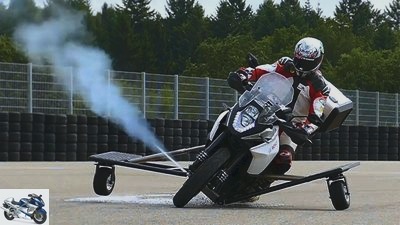
Bosch
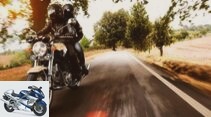

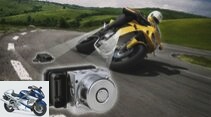
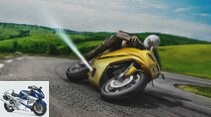
17th pictures
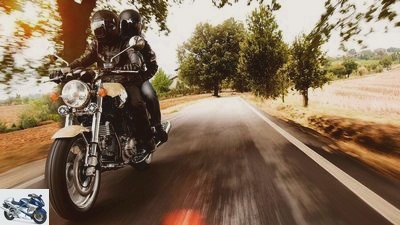
Bosch
1/17
To make motorcycling even safer, Bosch is developing numerous new assistance systems.

Bosch
2/17
Motorcycles should learn to see and feel, a magic hand should significantly reduce the risk of falling.
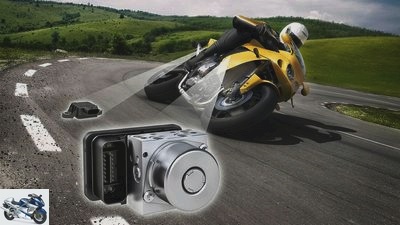
Bosch
3/17
ABS, stability and traction control are already standard or optional in a wide range.
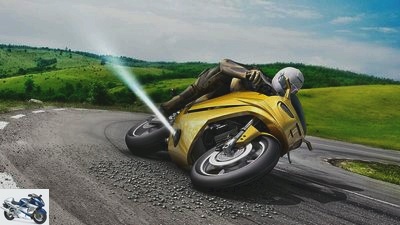
Bosch
4/17
The anti-slip device is still a long way off, but Bosch has already dedicated a research project to it.

Bosch
5/17
If a motorcycle comes into a driving situation where the tires can no longer build up sufficient cornering forces, a targeted Gaussian output should bring the bike back on track.
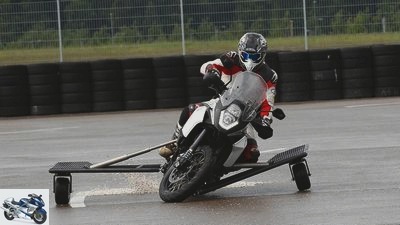
Jacek Bilski
6/17
If the wheels lose their grip when cornering, there is a risk of a fall.
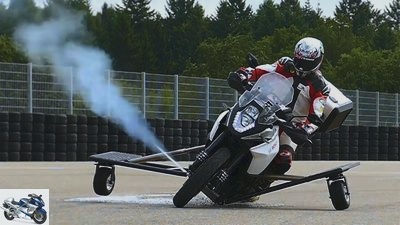
Bosch
7/17
If a sensor detects that the wheel is slipping sideways and a certain value is exceeded, gas escapes through a gas pressure accumulator, which is also used to activate an airbag in a car.

Jacek Bilski
8/17
The gas flows into the tank adapter and escapes in a targeted manner via a nozzle.
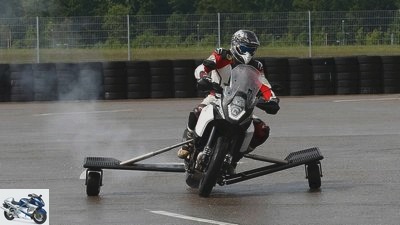
Jacek Bilski
9/17
The force impulse from the gas ejection stabilizes the journey.
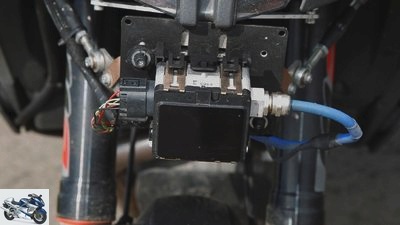
Jacek Bilski
10/17
In the prototype, the sensors are in front of the fork.
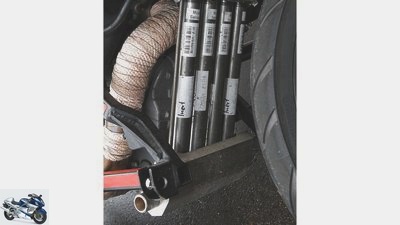
Jacek Bilski
11/17
The gas cartridges were placed upright in front of the engine.
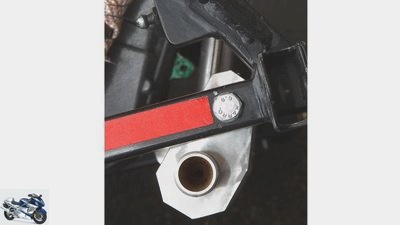
Jacek Bilski
12/17
The gas is ejected through these nozzles.

Bosch
13/17
The networking of vehicles, especially motorcycles and cars, should reduce the risk of accidents by around a third.

Bosch
14/17
The radar-based adaptive cruise control (ACC) adapts the speed of the motorcycle to the traffic flow and maintains the necessary safety distance from the vehicle in front.
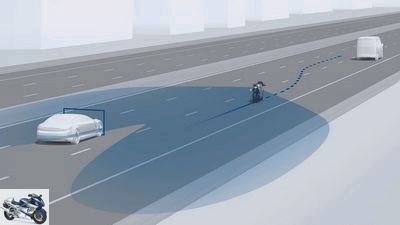
Bosch
15/17
If the biker overlooks an object in his blind spot, a blind spot warning system based on a rear radar warns with an optical signal, for example in the rear-view mirrors.
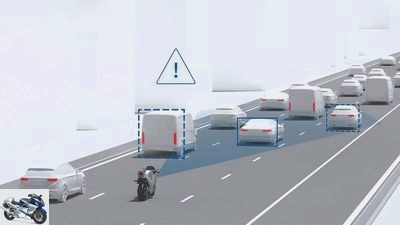
Bosch
16/17
The new collision warning system, which also uses the front radar, monitors the area in front of the bike.
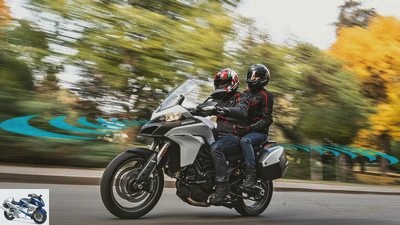
Ducati
17/17
The new driver assistance systems will go into series production at motorcycle manufacturers KTM and Ducati as early as 2020.
counselor
technology & future
New Bosch motorcycle safety systems
New Bosch motorcycle safety systems
Gas kick as a fall saver
To make motorcycling even safer, Bosch is developing numerous new assistance systems. Motorcycles should be like that “Learn to see and feel”, a magic hand should significantly reduce the risk of falling.
Michael Schumann, Uli Baumann
05/17/2018
According to statistics, the risk of motorcyclists being killed in an accident is up to 20 times higher than that of motorists. In order to make motorcycling safer, more and more electronically controlled driving systems are finding their way into modern bikes. ABS, stability and traction control are already mandatory as standard or at least optional in many areas. And if Bosch goes, there will be a few more in the future. Many of them are already known from the automotive sector.
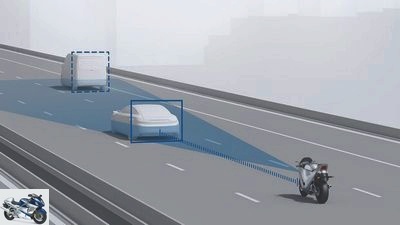
Bosch
Radar systems monitor the area around the motorcycle.
New driver assistance systems will go into series production at motorcycle manufacturers KTM and Ducati as early as 2020. The safety package then includes adaptive distance and speed control. A collision warning and a
Blind spot assistant can also be easily implemented with the help of the radar-based system. The core, however, is adaptive cruise control (ACC). The cruise control adapts the speed of the motorcycle to the flow of traffic and maintains the necessary safety distance from the vehicle in front. This function, which can be switched off, is intended, on the one hand, to make it easier to drive in a column and also to help avoid rear-end collisions. But it must by no means be called “Self-driving function” (automated driving). The driver must have a 100 percent view of the traffic situation at all times and can intervene.
The new collision warning system, which also uses the front radar, monitors the area in front of the bike. If the system detects a critical approach to a vehicle in front and the driver does not react to the dangerous situation, it warns the driver via an acoustic, visual or even haptic (e.g. vibrating handles) signal. If the biker overlooks an object in his blind spot, a blind spot warning system based on a rear radar warns with an optical signal, for example in the rear-view mirrors.
Back on track with the accelerator
The anti-slip device is still a long way off, but Bosch has already dedicated a research project to it. If a motorcycle comes into a driving situation in which the tires can no longer build up sufficient cornering force, i.e. slip away, the motorcyclist has almost no chance at a certain point to straighten the bike. In order to get back on track, an additional side force has to be applied. The anti-slip device should apply this. The how sounds a bit like Daniel Dusentrieb, but Bosch has already shown that it works:
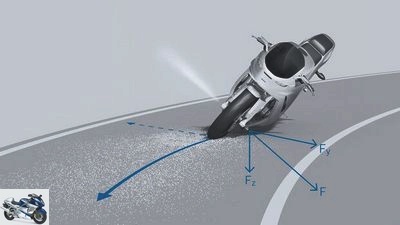
Bosch
The motorcycle is brought back on track with a specific impulse.
Recognizes the in the MSC (Motorcycle Stability Control, Bosch abbreviation for “Cornering ABS”) that the wheel slips sideways and a certain value is exceeded, gas escapes through a gas pressure accumulator, as is also used to activate an airbag in a car. According to Bosch, the trigger time lasts five milliseconds. The gas flows into the tank adapter and escapes through a nozzle with a bang. This recoil force against the direction of slip gives the motorcycle an impulse so that the tires get grip again and the motorcycle gets back on track. On the test motorcycle, a KTM 1190 Adventure (see video), the gas supply is held in an exchangeable cartridge. According to Bosch, other systems would also be conceivable for a possible series application.
The gas pressure-based anti-slip device is still at the absolute research stage, emphasizes Bosch. “We have proven through tests that such a system works. How this system can ultimately be implemented in a practical manner is still open”, explains Fevzi Yildirim, head of the two-wheeler division at Bosch Europe. One is still from a possible series launch “several years” removed.
Vehicles will talk to each other
Car-to-car communication is sure to come. The networking of vehicles, especially motorcycles and cars, should reduce the risk of accidents by around a third. Together with Ducati and companies specializing in vehicle IT, Bosch developed the prototype of the car-motorcycle connectivity and has now presented it. The system is intended to ensure “digital visibility” of the often overlooked motorcyclists, especially for motorists, and thus also to significantly increase their safety. “We’re creating the digital protective shield for motorcyclists,” says Bosch managing director Dirk Hoheisel.
\ n<div class = \&# 34; v-A_-custom-html v-A_-custom-html – video \ “>\ n<iframe width = \&# 34; 580 \&# 34; height = \&# 34; 315 \&# 34; src = \&# 34; https: //www.youtube.com/embed/Cfn5sbUqHig \&# 34; frameborder = \&# 34; 0 \&# 34; allowfullscreen></ iframe>\ n</ div>\ n</ div>\ n&# 34;,&# 34; consentGroup&# 34;: null}”>
Transmission times of just a few milliseconds
This is how it works: Vehicles within a range of several hundred meters exchange information about the vehicle type, current speed, position and direction of travel up to ten times per second. Long before a motorcycle comes into view for the driver and the vehicle’s own sensors, according to Bosch, thanks to the technology, they know: watch out, a motorcycle is approaching. That would enable improved, anticipatory driving. The crux of the matter: In order for this to apply across the board, both the car and the motorcycle must have the technology on board. Or the other way around: if you don’t have it, you have no protection whatsoever.
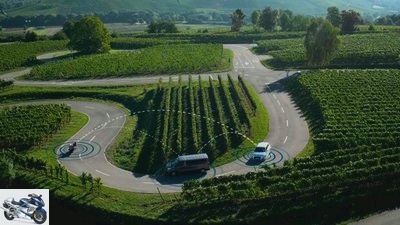
Bosch
In the future, vehicles should exchange information.
The data exchange between motorcycle and car should be based on the WLAN standard pWLAN (ITS G5). According to Bosch, this enables short transmission times of just a few milliseconds between the transmitter and receiver. Every road user involved would be able to generate and send information that is important for the traffic situation.
Stationary vehicles could also send data to the environment. The technology relies on so-called “multi-hopping” so that motorcycles and cars that are further away can reliably receive the necessary information. According to Bosch, the information is automatically passed on from vehicle to vehicle.
Until when the new safety technology of the “digital protective shield” can actually be brought into circulation is still open.
More security systems will come
Networking, swarm intelligence, autonomous driving – these are all keywords that developers deal with nowadays, while most motorcyclists are dreadful. At the beginning of 2017, MOTORRAD interviewed Bosch chief technician Fevzi Yildirim.

Hertler
Bosch chief technician Dr. Interview with Fevzi Yildirim.
MOTORCYCLE: Mr. Yildirim, you are European head of the Bosch two-wheeler division and in this role you are also responsible for all motorcycle technology. We observe that many motorcyclists reject electronics as soon as they go beyond ABS. For various reasons, be it because it is no longer transparent how it works or whether it works at all. Or they fear being patronized by electronics. Quite a blanket – what do you say to such skeptics?
Dr. Fevzi Yildirim: Look, I’m a motorcyclist myself. And I only want electronics when I actually need them. All in all – our aim is to make motorcycling safer without impairing driving pleasure.
MOTORCYCLE: And specifically? Where do you see a need and how can you achieve it?
Dr. Fevzi Yildirim: If you look at the number of accidents in Germany over the past ten years, you will see that there has been a significant decrease in car accidents. Why? Because various measures have been taken, including the introduction of active safety systems such as the ESP anti-skid system. This has reduced the number of people killed and injured in road traffic. In contrast, the number of accidents with motorcycles in Germany has remained almost constant, in other countries they are increasing significantly in some cases. We have to change that.
MOTORCYCLE: There is nothing wrong with that. But how?
Dr. Fevzi Yildirim: For example, by continuously improving all systems and by bringing technologies such as motorcycle ABS into all classes and markets. ABS can prevent up to one in four motorcycle accidents with fatalities and injuries. But we cannot stop there. That is why in 2013 Bosch ignited the next level of safety with the MSC motorcycle stability control. This year we will push up our semi-active damping control.
MOTORCYCLE: You have to explain that to us. What does the damping have to do with more security??
Dr. Fevzi Yildirim: With the semi-active damping control, we can influence the chassis depending on the situation. For example, we can use it to prevent the front wheel from submerging when braking sharply. By influencing the damping characteristics of the two wheels in a targeted and situation-appropriate manner, we can achieve better contact with the road and thus shorter braking distances. This also makes the bike more stable. Incidentally, we deliberately developed the system on the basis of the existing ABS electronics, as these meet the high automotive safety standards. Other systems that are on the market are part of so-called consumer electronics that do not meet these standards.
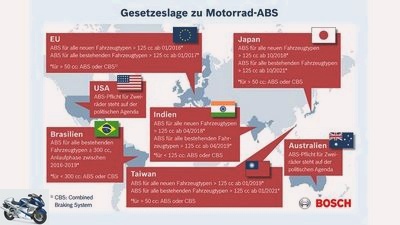
Bosch
Legal ABS requirements worldwide.
MOTORCYCLE: This means that Bosch electronic damper control is safer than others?
Dr. Fevzi Yildirim: Exactly. The electronics are safer, more robust and more reliable. But there is one more point. We integrate the semi-active damping control into our MSC (Motorcycle Stability Control, colloquially also cornering ABS, Red.). This ensures that everything is perfectly coordinated and we achieve a much better effectiveness of the function itself. This means that when you are braking or accelerating, the system acts exactly as the situation requires.
MOTORCYCLE: Because all components speak the same programming language, the system works faster and more efficiently?
Dr. Fevzi Yildirim: Above all, more efficient. The sensor box that we need for our MSC always makes it clear what the motorcycle is doing. We know the lean angle that is used. The average vehicle speed is known via the speed sensors, in short, we have all the information available so that the function of the semi-active damping control is more intelligent and better, and ultimately safer.
MOTORCYCLE: If the electronics become cheaper, the application will be easier if the motorcycle manufacturers say that we will buy the whole package from Bosch?
Dr. Fevzi Yildirim: Of course, when everything comes from a single source, development is more economical. In our opinion, this does not make motorbikes more expensive. Ultimately, however, pricing is a matter for the motorcycle manufacturer.
MOTORCYCLE: Sometimes away from the price and towards the topic of reliability. Electronic components in motorcycles are also exposed to the highest levels of stress. How resistant to heat, dust, vibrations, etc. is modern electronics?
Dr. Fevzi Yildirim: There are clearly defined standards. Not just at Bosch, but across the industry. They are called ASIL (Automotive Safety Integrity Level, Red.). Today, ABS and ESP have to meet the highest requirements that such components can have. We are talking about ASIL D. We have achieved failure rates, so we’re talking about “parts per million”. If a part of a million fails, then physical limits have been reached that are embedded in the technology. As you know, we manufacture our motorcycle ABS, which is also the basis for the MSC, in Japan. From there we bring these high standards to mass markets such as India.
MOTORCYCLE: Do these standards also include a life expectancy guarantee for the systems?
Dr. Fevzi Yildirim: Naturally. At the moment we expect a service life of 15 years for ABS. Incidentally, this is the same for cars, so it is by no means motorcycle-specific. And a mileage of 100,000 kilometers for motorcycles.
MOTORCYCLE: Let’s take a general look into the future and please describe to us what a motorcycle can do better in three or four years than it is today.
Dr. Fevzi Yildirim: First of all, I can say that in three or four years, a motorcycle will be just as fun as it is today. I’m interested in that myself, that’s important to me. In the future, we will bring the motorcycle to the Internet and network it with its environment. In addition, the further improvement of safety remains a major issue, for example in the form of additional assistance systems.
MOTORCYCLE: What does that mean in concrete terms? There will probably be no parking aid like in a car.
Dr. Fevzi Yildirim: Certainly not. A first example is the blind spot assistant, which we brought into series production together with BMW in the C 650 scooter at the end of 2015 and which is very helpful in city traffic. I can very well imagine other functions that increase safety, such as lane keeping assistance, a curve speed warning system or traffic sign recognition.
MOTORCYCLE: Would an automatic braking intervention on the motorcycle also be conceivable for you? This means that the motorcycle recognizes a potential danger and brakes on its own.
Dr. Fevzi Yildirim: For this, of course, appropriate environmental sensors are required, but this would be technically possible.
MOTORCYCLE: Fine, but is that what you really want?
Dr. Fevzi Yildirim: Our MSC system can do that today. But we didn’t technically realize that. MSC only acts when the motorcyclist specifies an action, i.e. accelerates or brakes. I don’t see a brake assistant that automatically brakes the motorcycle to a standstill from a certain trigger threshold. If the system works completely independently of the motorcyclist, then I even consider it dangerous. Nevertheless, this already gives us the opportunity to improve security. Just think of an inexperienced driver who approaches an obstacle and brakes. Now the system recognizes: the driver is not braking enough, a crash will inevitably occur. In this context, I can very well imagine that our system helps motorcyclists to prevent worse things from happening.
MOTORCYCLE: We can imagine that quite well. But to the environmental sensors you mentioned. Do you mean distance radar and cameras, including on a motorcycle? When does this technology come??
Dr. Fevzi Yildirim: The technology already exists, and we are already on the road to try it out. I am confident that we will see systems like this on the market for two-wheelers in the next five years.
MOTORCYCLE: That sounds quite exciting. But the human factor remains. Isn’t he tempted to take greater risks by more and more electronics??
Dr. Fevzi Yildirim: No. Electronics only intervene when I reach physical limits, when things get tricky. We had exactly the same question with the car ESP. In other words, whether motorists are tempted to take more risk through ESP. The significant decrease in the number of accidents and thus the number of fatalities and injuries shows that the opposite is the case. But don’t get me wrong, I am for driving pleasure. Our goal is to increase safety while maintaining the fun factor. And I am also in favor of the fact that you have to be able to feel the core elements of motorcycling, the combustion engine, the acceleration, the lean angles, that you can feel it all.
MOTORCYCLE: We have a lot in common. Which brings us directly to another topic, namely the cleanliness of internal combustion engines. What is Bosch doing there?
Dr. Fevzi Yildirim: Besides safety, efficiency is the other big issue. We probably all don’t mind if we emit fewer pollutants when riding a motorcycle. We’re working on that as well. The Euro 5 standard will come in 2020. Not only in Europe, by the way. The same applies to India, where Euro 5 comes at the same time as Europe, even if the standard there is called differently, namely BS6. We at Bosch are prepared for this and we will offer solutions. This also applies to the then mandatory onboard diagnosis.
MOTORCYCLE: A few weeks ago, Bosch introduced the option of networking the driver’s smartphone with the motorcycle, which should give the driver the opportunity to see incoming emails in the cockpit, for example. Seriously: who needs that??
Dr. Fevzi Yildirim: Well, there’s more to it now, but I’ll get to that in a moment. First of all: I have two children, teenagers, who are not at all interested in today’s motorcycles. When I was that old it was different. But my children are interested in their smartphones and the possibilities they offer them. So in order to make two-wheelers attractive for young and future generations too, we have to combine both technologies. In other words, our generation today is able to use technology. But the next generation that lives in this technology. So we need this step to make motorcycles interesting again for future generations.
And as far as the integration of apps into the motorcycle display is concerned, we have developed the mySPIN platform, which, by the way, works equally with Android and Apple apps. It offers the option of transferring, or mirroring, various apps from the smartphone to the display. So in the future I will no longer need my own sat nav, I can use the cell phone sat nav while driving. However, mirroring does not mean that all images are transferred one-to-one from the mobile phone. Instead, they are simplified and optimized, tailored to the needs of the motorcyclist, who only needs very specific information at a specific time. We show the driving-specific information such as speed or engine speed in our display anyway, the basics are integrated, as in the analog system today.
MOTORCYCLE: If I get additional information now, it doesn’t distract from driving?
Dr. Fevzi Yildirim: How come? If you use an additional navigation system in addition to your cockpit today, you even have two screens that you have to keep an eye on. As a motorcyclist, I have a huge advantage when the information on the display is clearer and more visible. I would advise against watching a film while driving (grins, editor) – by the way, it is not even possible. Our display instrument will be on the market next year. We are very curious to see how well the product will be received.
MOTORCYCLE: Another technology that is advancing at breakneck speed is the networking of vehicles with one another, keyword “connected horizon”. It should recognize dangerous situations in advance – for example the slippery road surface in a curve or the end of a traffic jam on the motorway – and warn the driver of this. But how could that work, in what form should the warning be given? You don’t look at your display all the time.
Dr. Fevzi Yildirim: That’s right. A warning would therefore have to be haptic, for example in the form of a very light braking impulse, which has no influence on the motorcycle and its driving behavior, but is noticeable to the driver.
MOTORCYCLE: Doesn’t this networking make us even more transparent than we already are through our cell phones alone? Can’t the police read along here when we drove where and how fast? There are such fears in the room. How do you respond to them?
Dr. Fevzi Yildirim: As you say yourself, you are already revealing a lot about yourself through your cell phone. But only very few are really aware of this. Ultimately, it is not we, but the vehicle manufacturer who decide which data the motorcycle collects. It is clear to us: Networking is only successful with trust, trust in the function and in the protection of the data. Bosch will handle customer data very responsibly and transparently. We will tell our customers exactly what data we are using for what purpose and we will ask their permission to do so. There is also data collection that is not personal or cannot be related to a person. Regardless of the networking, these serve to better understand driving or braking behavior and thus ultimately to increase safety again.
MOTORCYCLE: Who does the data on my motorcycle belong to? Me as the owner, the vehicle manufacturer, the system manufacturer? Who can and may decide about it?
Dr. Fevzi Yildirim: That is a legal issue. Data protection is regulated by national laws. From our point of view, comprehensive regulations are required here in order to create uniform legal certainty for the largest possible markets. That is why we are also in favor of the rapid implementation of the EU data protection directive in order, among other things, to set a framework for the use of personal data.
MOTORCYCLE: Shouldn’t there just be a switch that the motorcyclist can use to turn off the connectivity of his machine when necessary? For example, it’s none of my car insurance business if I am
sometimes go to the racetrack with my Fireblade or not.
Dr. Fevzi Yildirim: We have to make a clear distinction here between what is technically possible and what is socially and legally accepted. If politics and society want these possibilities, then we can implement them.
MOTORCYCLE: Keyword politics and society – would it be conceivable for Bosch to use GPS to automatically brake a motorcycle to locally applicable speed limits, i.e. simply not allow driving too fast?
Dr. Fevzi Yildirim: We now have such precise map data that the motorcycle can easily recognize, for example, that there is a 90-degree bend in 50 meters, but the driver is racing towards it with 150 things and will never, ever get through this bend without it it dismantled him. Sure, the system could then act independently of the driver. But, again, the question is not what is technically possible. The question is, what do we do with it? And we have to find the answer to this together with the motorcycle manufacturer and the motorcyclist.
MOTORCYCLE: Has a vehicle manufacturer already asked about the possibility of automatically braking to the speed limit??
Dr. Fevzi Yildirim: no.
MOTORCYCLE: What is excluded for you, what should never be implemented in the motorcycle sector?
Dr. Fevzi Yildirim: We are not developing automated driving.
MOTORCYCLE: Very reassuring. But the question was also meant morally and politically.
Dr. Fevzi Yildirim: I believe that it is morally imperative, but also politically necessary, to make motorcycles safer. I am not only thinking of Europe. I am also thinking of the millions of motorcycles that are on the road in Asia, for example. Look, in India alone more than 25,000 people are killed in motorcycle accidents every year. Any measure that reduces this and thus allows the motorcycle to find its place in the future is welcome.
MOTORCYCLE: This means that you see the technical development not only in terms of safety features and as a potential lifesaver, but also as a protection for the future of the motorcycle in general?
Dr. Fevzi Yildirim: You say so. If the motorcycle is to have a future, we definitely need an increase in safety. If motorcycles, regardless of internal combustion engine or electric drive, do not become safer around the world, then they may not have a future.
MOTORCYCLE: Thank you for talking to us, Mr. Yildirim.
About Dr. Fevzi Yildirim
Anyone who has worked for the Swabian supplier Bosch for 18 years inevitably comes into contact with very different areas of individual mobility. The aerospace engineer Yildirim (born in 1967, father of two) started in 1998 as a specialist in research and advance development, responsible for injectors, fuel pumps and hydraulics, before moving to the motorcycle safety division from Bosch in Japan in 2011. Since 2016 he has been Head of Development Two-Wheeler and Powersports at the Bosch locations in Abstatt and Schwieberdingen.
Related articles
-
Motorcycle safety yesterday and today
Security campaign Consideration has right of way Arnold Debus Motorcycle safety yesterday and today Motorcycle safety yesterday and today lead by…
-
Active safety systems in motorcycles
Bosch 10 pictures MOTORCYCLE archive 1/10 ABS – Should prevent the wheels from locking when braking hard or on slippery surfaces. KTM 2/10 “Cornering ABS…
-
Additional safety through assistance systems
Security campaign Consideration has right of way Yixin Chen 7th pictures Yixin Chen 1/7 Bosch 2/7 Adaptive Cruise Control adapts the speed to the flow of…
-
KTM counselor technology & future Ducati KTM safety systems Ducati and KTM safety systems Front and rear radar ready for series production by 2020 Ducati…
-
Motorcycle anti-lock braking systems in a comparison test
Jahn 13th pictures Jahn 1/13 The relations shift on the wet test track – in the truest sense of the word. Jahn 2/13 In conclusion, it can be said that…
-
Bosch counselor technology & future eCall systems for motorcycles eCall systems for motorcycles Challenges in accident detection and emergency calls A…
-
DVD on motorcycle driving safety
Sports & scene DVD on motorcycle driving safety DVD “Motorcycles ride well and safely” Price reduced to 9.90 euros Motorcycles ride well and safely…
-
Tips for mechanics: Maintenance of motorcycle cooling systems
Ralf Petersen 15th pictures Ralf Petersen 1/15 We explain how the maintenance of a cooling system works. Ralf Petersen 2/15 This is needed for…
-
Driver assistance systems for motorcycles
Hirano Ami counselor Driving experience & Driving tips Driver assistance systems for motorcycles Assistance systems For comfort and security Motorcycles…
-
Motorcycles are networked for more safety
CMC 17th pictures 1/17 This is how the warning of an upcoming construction site that was previously not visible on the curve could look like. The key to…